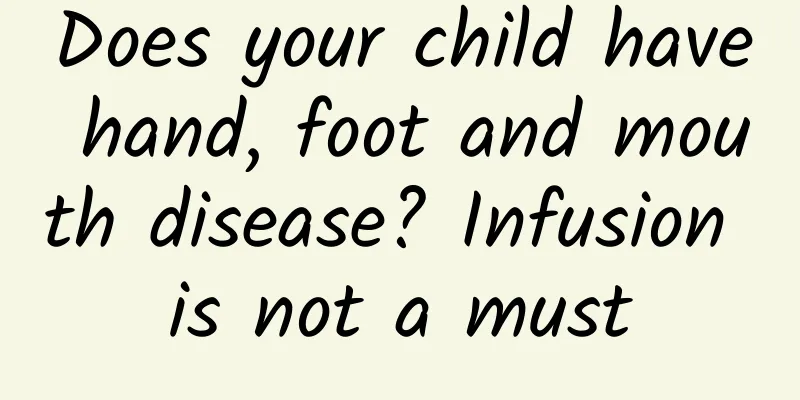Does your child have hand, foot and mouth disease? Infusion is not a must

|
Reading time: 5 minutes, the full text is about 850 words Hand, foot and mouth disease (HFMD) is a common infectious disease in children, causing a lot of anxiety among parents every year. Although most children have mild symptoms, the misconception that "infusion therapy is more effective" is still prevalent. Data show that the intravenous infusion rate for children with mild HFMD in some primary hospitals in my country is as high as 60%, far exceeding the 10% threshold recommended by the WHO. This article combines evidence-based medicine with cutting-edge technology to analyze the hazards of excessive infusion and reshape the logic of scientific nursing. Current misunderstanding: the underlying cause of infusion dependence 1. Cognitive bias: Parents simply associate "infusion = quick recovery" and ignore the self-limiting nature of viral infections. 2. Medical inertia: Some grassroots institutions are limited in their ability to detect pathogens and adopt the conservative approach of "broad-spectrum antiviral antibiotics". 3. Economic driver: The higher medical costs caused by infusion exacerbate unnecessary medical practices. Scientific evidence: There are no specific antiviral drugs for hand, foot and mouth disease pathogens (EV71, CoxA16, etc.), and mild cases only require symptomatic support. Infusion may cause risks such as allergic reactions and electrolyte imbalance, but the rate of severe illness has not been reduced. Cutting-edge technology enables precision care 1. Molecular diagnostic technology: Rapid nucleic acid testing (POCT) can identify pathogen subtypes within 15 minutes and differentiate between mild and severe risks. 2. AI Early Warning System: The dynamic monitoring model based on body temperature, heart rate, and rash progression can predict severe disease progression 48 hours in advance. 3. Microfluidic rehydration technology: Oral rehydration salts (ORS) combined with smart wearable devices can monitor the degree of dehydration in real time and avoid blind infusion. Three cores of scientific nursing 1. Fever management: If the body temperature is less than 38.5℃, physical cooling should be given priority, and ibuprofen/acetaminophen should be used only when necessary. 2. Accurate fluid replenishment: Oral rehydration salt III (osmotic pressure 245mOsm/L) is the first choice for mild dehydration, which is as efficient as intravenous rehydration. 3. Identification of severe cases: Persistent high fever (>3 days), tremors, and shortness of breath require immediate medical attention. Conclusion: Hand, foot and mouth disease care needs to shift from "experience-driven" to "evidence-driven". Through the combination of molecular diagnosis, intelligent monitoring and evidence-based care, more than 30% of unnecessary infusions can be reduced. Parents should establish a scientific understanding of "observation-assessment-tiered intervention", and medical institutions need to strengthen pathogen detection capabilities and guideline implementation. Only by breaking the misunderstanding can the interests of children be maximized. Data support source: 1. National Health Commission's "Guidelines for the Diagnosis and Treatment of Hand, Foot and Mouth Disease (2023 Edition)" 2. The Lancet Regional Health 2022 China Medical Behavior Study 3. Stanford University AI Early Warning Model Paper (2023) 4. WHO Guidelines for the Use of Oral Rehydration Salts 5. China CDC 2023 Hand, Foot and Mouth Disease Surveillance Report |
<<: How big is the largest earthquake in human history? What is the limit of earthquakes?
Recommend
The efficacy of Chinese herbal medicine
Rheumatism is a chronic disease that can make pat...
Verbena for skin
The name verbena is unfamiliar to many people, bu...
The "Exploration No. 1", which once caught lionfish and hook shrimp in the deep sea of 10,000 meters, has completed a new mission
On the afternoon of January 26, the "Explora...
I always feel that men are greasy, but why are men's faces more oily?
Sometimes I have to sigh that it is not easy for ...
What are the functions of Panax notoginseng and Salvia miltiorrhiza?
The combination of Panax notoginseng and Salvia m...
What are the effects and contraindications of blood-skin vegetable?
Bloodleaf is slightly sweet and has the effect of...
The efficacy and function of mountain willow
There are many types of Chinese medicine. When we...
The efficacy and function of twisted sheath citronella
Cymbopogon truncatum is a kind of traditional Chi...
Can I still eat the stored Lingzhi if it is moldy?
Ganoderma lucidum can be said to be a magical med...
UFOs spotted in the sky over many places, are they aliens or weapons from other countries? The truth is →
Around 6 p.m. on January 14, 2024, people in many...
The efficacy and function of four-wheel incense
Do you know what Silunxiang is? It is a kind of t...
If you are sick, can intravenous infusion help you get better quickly? The answer may not be what you think
Author: Zhao Zhigang, Chief Pharmacist, Beijing T...
As we advance deeper into space, what should we do if we encounter a fire?
Author: Qian Hang, aerospace science expert at th...
The efficacy and function of milk
Traditional Chinese medicine is a Chinese traditi...
The high bypass ratio engine is put into use, and the combat capability of the Y-20 has undergone a qualitative change
In April 2023, many people found that there was s...









